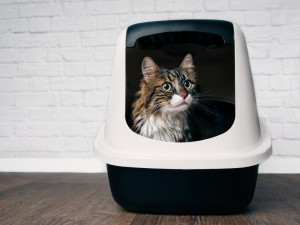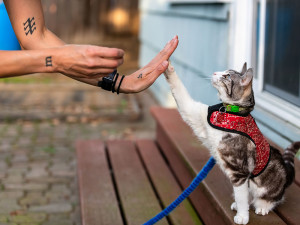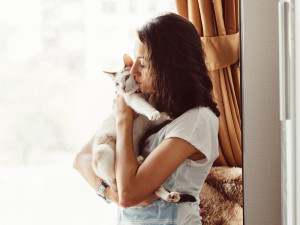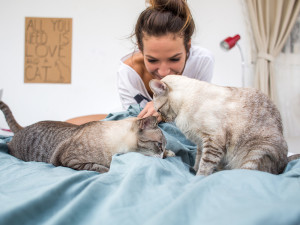Mastering the Art of Litter Box Training: How to Train Cats to Use a Litter Box
If you do nothing else, teach your cat to poo in their litter box (and not in your shoe)
Toilet training for cats is pretty important (OK, that’s an understatement), so setting up a litter box and making sure your cat knows where to do their business should be the first step in cat parenthood. Fortunately, toilet training cats is pretty simple. “There’s not a lot of training required,” says Washington State University School of Veterinary Medicine professor Dr Jessica Bell.
Why is litter box training important for cats?
For those cats who don’t pick up toilet training right away, the inability to use a litter box can be extremely disruptive; it’s not cool for your cat to turn the house plants or your favourite slippers into their toilet. It’s not ideal for your cat, either, who’s a huge fan of consistency and just wants to do their business in peace.
What type of litter box should I use?
Deciding which litter box to pick from the myriad options at the pet shop can be complicated. There are different types of cat litter boxes with pros and cons: big box? Little box? Covered box? Robot litter box? It depends, according to Dr Bell.
For kittens, she suggests starting with a smaller, shallow box that’s easier for them to climb into, then begin increasing the size as they grow. “Adult cats don’t like small, cramped litter boxes,” she says. “The bigger the cat, the bigger the box.” Some cats like covered boxes, while others prefer open boxes. You may have to try a few different options to see which one appeals to your cat when they experience the call of nature.
Similar to choosing a litter box, there are also cat litter pros and cons. Thankfully, the results are in:
Scientists have actually researched litter preferencesopens in new tab and found that cats prefer clay litter to silica (sand) or wood pellets.
Make sure the litter is deep enough that your cat can bury their waste. It’ll improve the ambiance for everyone.
How long do kittens take to litter train?
Most kittens will use the litter box instinctively without any training at all, but some need a few days to get the hang of it. However, some kittens do take several weeks to figure out how to use the litter box.
How do I introduce my cat to the litter box?
Follow this step-by-step guide to train your cat to use a litter box.
1. Make introductions
Once the box and litter are chosen, the first step to litter box train a cat is to introduce your cat to their private toilet. Place adult cats in the box and offer few words of encouragement. You might need to hold your kitten’s paws and help them scratch around a little to get the idea; the rest should come naturally. “Most cats easily adapt to a good, clean litter box,” says Dr Bell.
2. Choose a serene spot
You like your privacy when you pee and your cat does, too. Choose a quiet spot like the bathroom for the litter box. This gives your cat a chance to relax without distractions (dogs running down the hall or housemates watching TikToks at full volume). Privacy is good, but don’t banish your cat to the nether regions of your house to access the litter box. Dr Bell notes that cats don’t want to expend too much energy trekking to the bathroom. The more hassle required to reach the box, the higher the likelihood your cat will find a ‘better’ spot to use.
3. Keep it clean
Your cat does their part by doing their business in a box; it’s your job to keep it clean. Dr Bell warns that cats will avoid dirty litter boxes and find other places to go to the loo. If you’d rather your kitty didn’t make unexpected deposits behind the couch because you failed to scoop their litter box, scoop it at least once a day and empty, scrub and refill the entire litter box once a week.
What should I do if my cat has accidents outside the litter box?
Sh*t happens, right? When you’re trying to figure out why your cat is not using the litter box – and instead going to the loo outside the litter box – it may take some detective work to figure out what’s wrong.
Experimenting with the size of the litter box and the type of litter might be all it takes to get your cat back into the box, according to Dr Bell. If that doesn’t work, make an appointment with your vet to rule out medical issues. Conditions like cat UTIs (urinary tract infections) or bladder stones can make your cat associate pain with their litter box, sending them to other spots to relieve themselves. Dr Bell says clearing up the medical issue should stop the accidents.
No matter how badly you want to yell, “Noooo!” and snatch up your cat when you catch them going to the bathroom on your new rug, scolding them is not the answer. “You want to offer positive reinforcement,” says Dr Bell. “If you scare them when they have an accident, it’s not going to help them with litter box training – stress can cause even more litter box problems.”
Frequently asked questions
When should I start litter box training my cat?
Kittens won’t be ready to use a litter box until they are three weeks old. If your cat is younger than that, they’ll need to be stimulated to go to the bathroom.
How can I encourage my cat to use the litter box consistently?
It’s important to make sure your cat feels comfortable using their litter box, so put it in an accessible place where they can see their surroundings, and make sure it’s kept clean.
Should I have multiple litter boxes for multiple cats?
It’s recommended to have one litter box for each cat in your house, in different places in your house, so if your cats aren’t getting along, they will feel safe using their box.
Why is my cat not using litter box?
If your cat isn’t using their litter box, it’s likely because it doesn’t suit their preferences, or they have found another place they would rather relieve themselves.









